Instrumented Nanoindentation Tests Applied to Bulk Metallic Materials: From Calibration Issue to Pile-Up Phenomena
Abstract
:1. Introduction
2. Set-Up, Materials, and Method
2.1. Calibration Set-Up and Protocols
2.2. Materials
2.3. Pile-Up in Ductile Metallic Materials
3. Results and Discussion
3.1. Calibration Protocol
3.2. Indentation H and Er Measurements
3.3. Pile-Up Phenomenon
4. Concluding Remarks
Funding
Informed Consent Statement
Conflicts of Interest
References
- Fisher-Cripps, A.C. A review of analysis methods for sub-micron indentation testing. Vacuum 2000, 58, 569–585. [Google Scholar]
- Elmustafa, A.A.; Stone, D.S. Stacking fault energy and dynamic recovery: Do they impact the indentation size effect? Mater. Sci. Eng. A 2003, 358, 1–8. [Google Scholar] [CrossRef]
- Zeng, K.; Soderlung, E.; Giannakopoulos, A.E.; Rowcliffe, D.J. Controlled indentation: A general approach to determine mechanical properties of brittle materials. Acta Mater. 1996, 44, 1127–1141. [Google Scholar] [CrossRef]
- Ma, Y.; Zhang, Y.; Yu, H.F.; Zhang, X.Y.; Shu, X.F.; Tang, B. Plastic characterization of metals by combining nanoindentation test and finite element simulation. Trans. Nonferrous Met. Soc. China 2013, 23, 2368–2373. [Google Scholar] [CrossRef]
- Doerner, M.F.; Nix, W.D. A method for interpreting the data from depth-sensing indentation instruments. J. Mater. Res. 1986, 1, 601–609. [Google Scholar] [CrossRef]
- Volinsky, A.A.; Gerberich, W.W. Nanoindentaion techniques for assessing mechanical reliability at the nanoscale. Microelectr. Eng. 2003, 69, 519–527. [Google Scholar] [CrossRef]
- Elmustafa, A.A.; Stone, D.S. Size-dependent hardness in annealed and work hardened α-brass and aluminum polycrystalline materials using activation volume analysis. Mater. Lett. 2003, 57, 1072–1078. [Google Scholar] [CrossRef]
- ISO/FDIS 14577-1. Metallic Materials—Instrumented Indentation Test for Hardness and Material Parameter for Standardization; ISO Copyright Case Postale 56, CH-1211; ISO: Geneva, Switzerland, 2002.
- Oliver, W.C.; Pharr, G.M. An improved technique for determining hardness and elastic modulus using load and displacement sensing indentation experiments. J. Mater. Res. 1992, 7, 1564–1583. [Google Scholar] [CrossRef]
- Wang, W.; Li, Z.; Yao, P.; Li, J.; Chen, F.; Liu, Y. Sink-in/pile-up formation and crack nucleation mechanisms of high purity fused silica and soda-lime silica glass during nanoindentation experiments. Ceram. Int. 2020, 46, 24698–24709. [Google Scholar] [CrossRef]
- Kese, K.O.; Li, Z.C. Semi-ellipse method for accounting for the pile-up contact area during nanoindentation with the Berkovich indenter. Scr. Mater. 2006, 55, 699–702. [Google Scholar] [CrossRef]
- Garrido Maneiro, M.A.; Rodríguez, J. Pile-up effect on nanoindentation tests with spherical–conical tips. Scr. Mater. 2005, 52, 593–598. [Google Scholar] [CrossRef]
- Wang, Y.; Raabe, D.; Klueber, C.; Roters, F. Orientation dependence of nanoindentation pile-up patterns and of nanoindentation microtextures in copper single crystals. Acta Mater. 2004, 52, 2229–2238. [Google Scholar] [CrossRef] [Green Version]
- Tabor, D. Hardness of Metals; Clarendon Press: Oxford, UK, 1951. [Google Scholar]
- Beegan, D.; Chowdhury, S.; Laugier, M.T. A nanoindentation study of copper films on oxidised silicon substrates. Surf. Coat. Technol. 2003, 176, 124–130. [Google Scholar] [CrossRef]
- Kese, K.O.; Li, Z.C.; Bergman, B. Method to account for the true contact area in soda-lime glass during nanoindentation with the Berkovich tip. Mater. Sci. Eng. A 2005, 401, 1–8. [Google Scholar] [CrossRef]
- Saha, R.; Nix, W.D. Soft films on hard substrates—Nanoindentation on tungsten films on sapphire substrates. Mater. Sci. Eng. A 2001, 319–321, 898–901. [Google Scholar] [CrossRef]
- Giannakopoulos, A.E.; Suresh, S. Determination of elastoplastic properties by instrumented sharp indentation. Scr. Mater. 1999, 40, 1191–1198. [Google Scholar] [CrossRef] [Green Version]
- Tsui, T.Y.; Oliver, W.C.; Pharr, G.M. Influences of Stress on the Measurement of Mechanical Properties Using Nanoindentation: Part 1. Experimental Studies in an Aluminum Alloy. J. Mater. Res. 1996, 11, 752–759. [Google Scholar] [CrossRef]
- McElhaney, K.W.; Vlassak, J.J.; Nix, W.D. Determination of indenter tip geometry and indentation contact area for depth-sensing indentation experiments. J. Mater. Res. 1998, 13, 1300–1306. [Google Scholar] [CrossRef]
- Zeng, K.; Chiu, C.H. An analysis of load-penetration curves from instrumented indentation. Acta Mater. 2001, 49, 3539–3551. [Google Scholar] [CrossRef]
- Oliver, W.C.; Pharr, G.M. Review: Measurement of hardness and elastic modulus by instrumented indentation: Advances in understanding and refinements to methodology. J. Mater. Res. 2004, 19, 3–15. [Google Scholar] [CrossRef]
- Saha, R.; Nix, W.D. Effects of the substrate on the determination of thin film mechanical properties by nanoindentation. Acta Mater. 2002, 50, 23–38. [Google Scholar] [CrossRef]
- Zhou, X.; Jiang, Z.; Wang, H.; Yu, R. Investigation on methods for dealing with pile-up errors in evaluating the mechanical properties of thin metal films at sub-micron scale on hard substrates by nanoindentation technique. Mater. Sci. Eng. A 2008, 488, 318–332. [Google Scholar] [CrossRef]
- Cheng, Y.T.; Cheng, C.M. What is nanoindentation hardness? Surf. Coat. Technol. 2000, 133–134, 417–424. [Google Scholar] [CrossRef]
- Cheng, Y.T.; Cheng, C.M. Can stress-strain relationships be obtained from indentation curves using conical and pyramidal indenters? J. Mater. Res. 1999, 14, 3493–3496. [Google Scholar] [CrossRef] [Green Version]
- Venkatesh, T.A.; Van Vliet, K.J.; Giannakopoulos, A.E.; Suresh, S. Determination of elasto-plastic properties by instrumented sharp indentation: Guidelines for property extraction. Scr. Mater. 2000, 42, 833–839. [Google Scholar] [CrossRef]
- Dao, M.; Chollacoop, N.; Van Vliet, K.J.; Venkatesh, T.A.; Suresh, S. Computational modeling of the forward and reverse problems in instrumented sharp indentation. Acta Mater. 2001, 49, 3899–3918. [Google Scholar] [CrossRef] [Green Version]
- Bolshakov, A.; Pharr, G.M.J. Influences of pileup on the measurement of mechanical properties by load and depth sensing indentation techniques. J. Mater. Res. 1998, 13, 1049–1158. [Google Scholar] [CrossRef]
- Cabibbo, M.; Ricci, P.; Cecchini, R.; Rymuza, Z.; Sullivan, J.; Dub, S.; Cohen, S. An international round-robin calibration protocol for nanoindentation measurements. Micron 2012, 43, 215–222. [Google Scholar] [CrossRef]
- Milman, Y.V.; Golubenko, A.A.; Dub, S.N. Indentation size effect in nanohardness. Acta Mater. 2011, 59, 7480–7487. [Google Scholar] [CrossRef]
- Campbell, C.J.; Gill, S.P.A. An analytical model for the flat punch indentation size effect. Int. J. Sol. Struct. 2019, 171, 81–91. [Google Scholar] [CrossRef]
- Ruiz-Moreno, A.; Hähner, P. Indentation size effects of ferritic/martensitic steels: A comparative experimental and modelling study. Mater. Des. 2018, 148, 168–180. [Google Scholar] [CrossRef]
- Hu, J.; Sun, W.; Jiang, Z.; Zhang, W.; Lu, J.; Huo, W.; Zhang, Y.; Zhang, P. Indentation size effect on hardness in the body-centered cubic coarse-grained and nanocrystalline tantalum. Mater. Sci. Eng. A 2017, 686, 19–25. [Google Scholar] [CrossRef]
- Xu, Y.; Balint, D.B.; Dini, D. A new hardness formula incorporating the effect of source density on indentation response: A discrete dislocation plasticity analysis. Surf. Coat. Technol. 2019, 374, 763–773. [Google Scholar] [CrossRef]
- Lu, S.L.; Zhang, J.Z.; Zhu, Y.K.; Zhang, P.; Zhang, Z.F. Revealing the size-independent hardness for geometrical similar indentations in metal. Mater. Lett. 2021, 293, 129684. [Google Scholar] [CrossRef]
- Nix, W.D.; Gao, H. Indentation size effects in crystalline materials: A law for strain gradient plasticity. J. Mech. Phys. Solids 1998, 46, 411–425. [Google Scholar] [CrossRef]



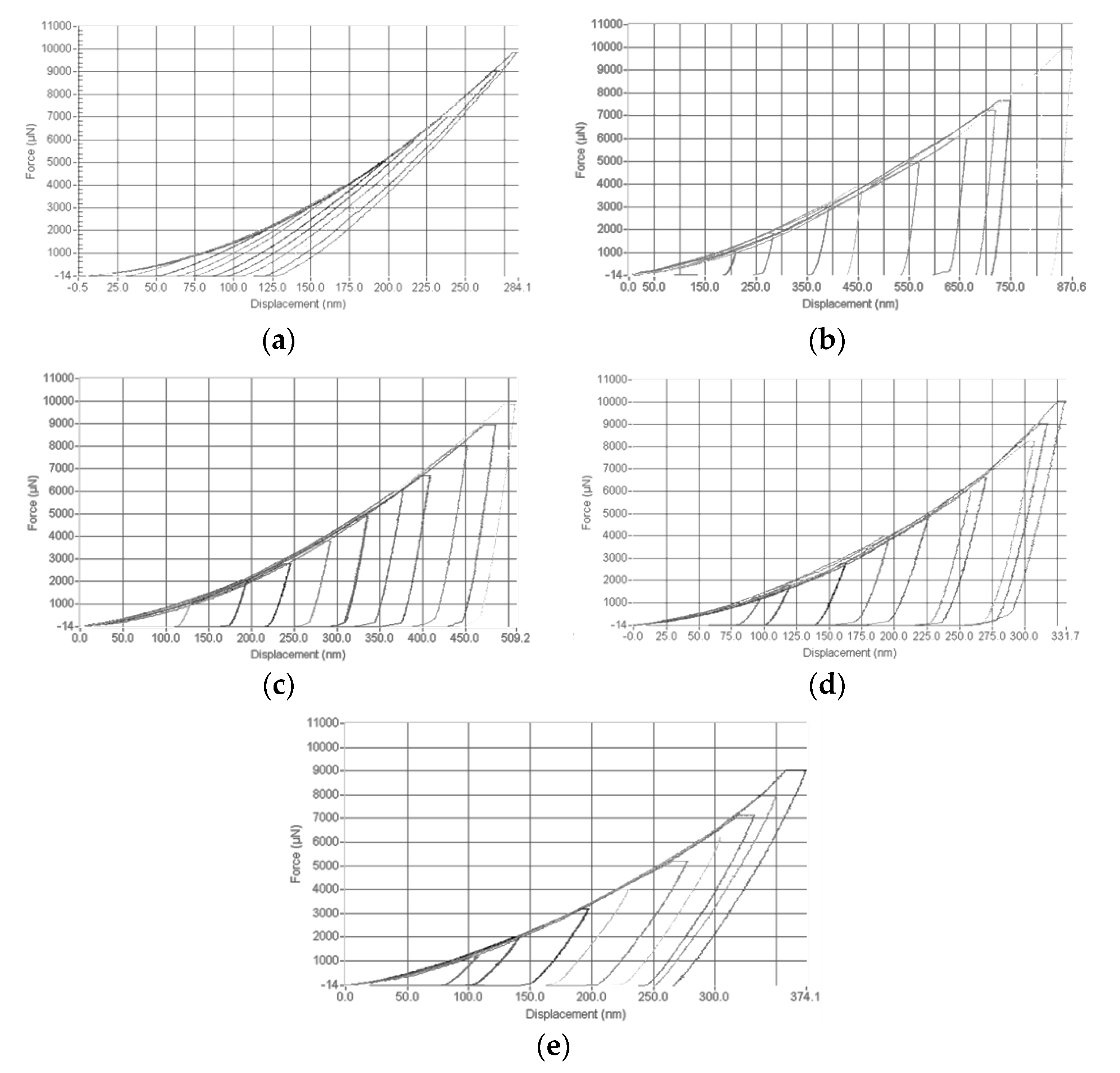

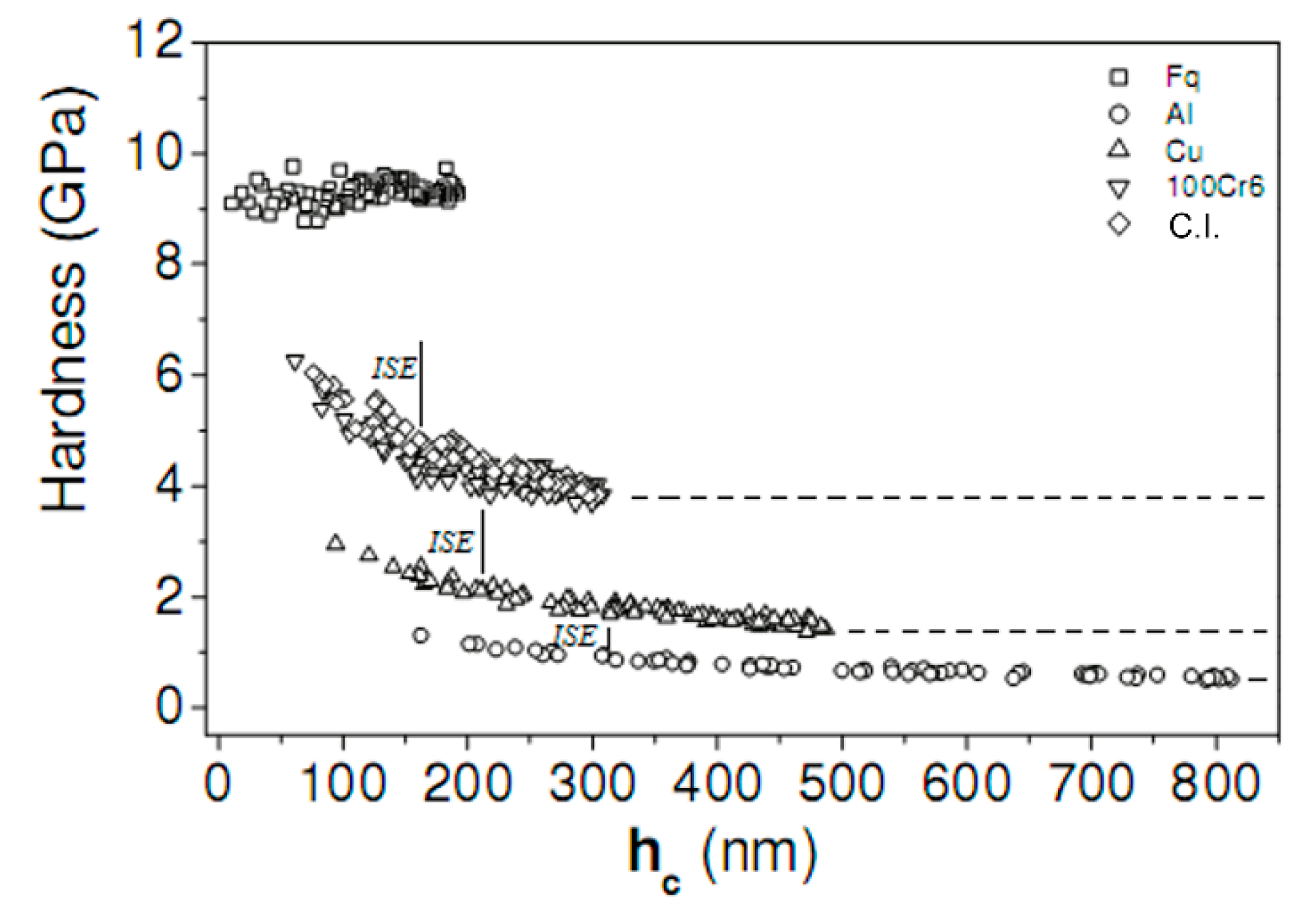
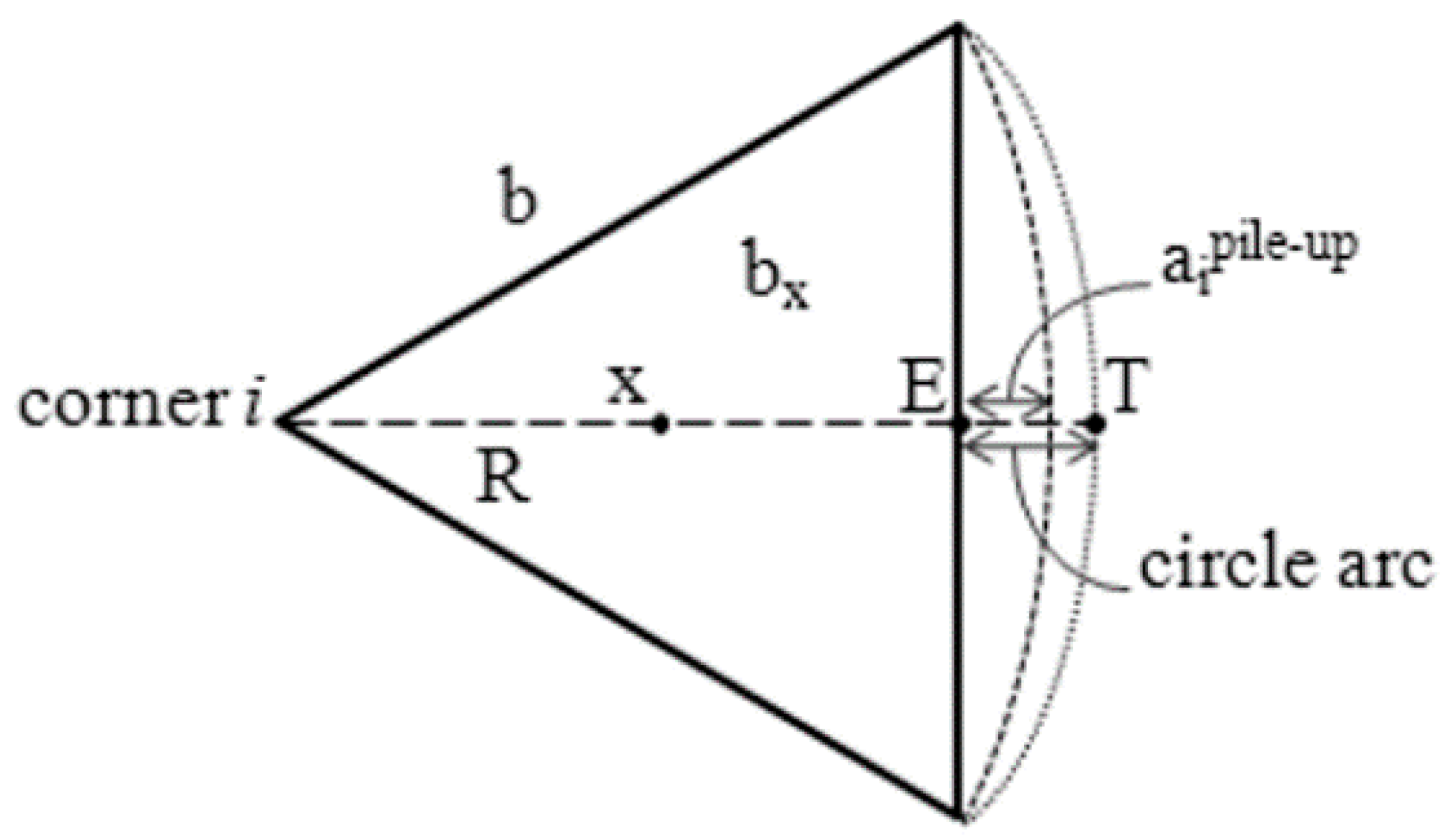

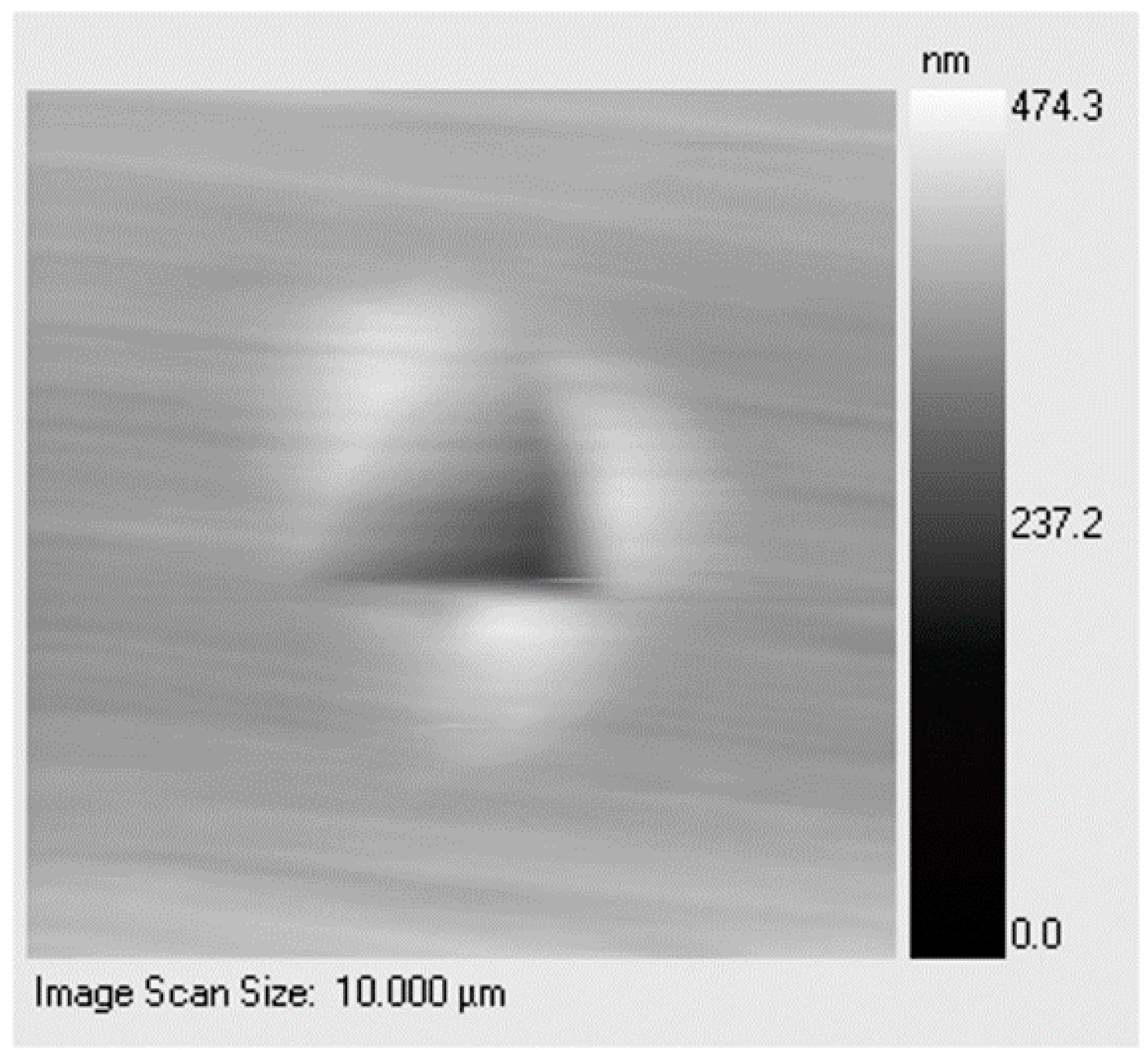
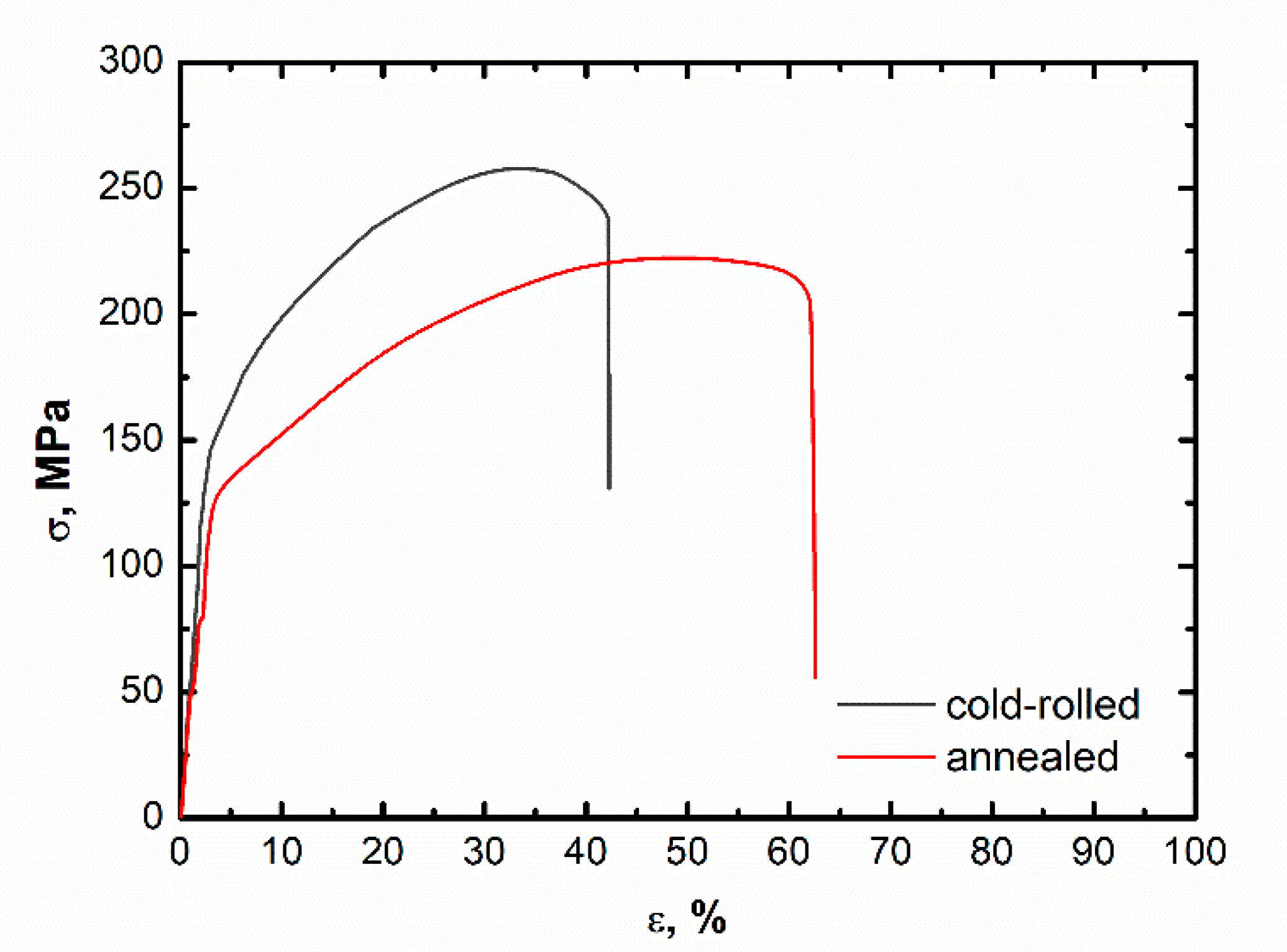
| Sample | Nanoindentation Hardness, GPa | Microhardness, GPa/HV |
|---|---|---|
| pure Al | 0.21 ± 0.02 | 0.198 ± 0.02/20.5 ± 0.5 |
| DHP Cu | 0.67 ± 0.05 | 0.64 ± 0.05/65 ± 2 |
| 100 Cr6 | 1.91 ± 0.04 | 1.94 ± 0.08/195 ± 5 |
| C.I. | 2.45 ± 0.05 | 2.43 ± 0.05/230 ± 5 |
| Sample | Constituent a/Constituent b, GPa | Fraction of Constituent a/Constituent b | Mean, GPa |
|---|---|---|---|
| DHP Cu | 0.74 ± 0.04/0.51 ± 0.02 | 0.58/0.42 ± 0.02 | 0.64 ± 0.08 |
| 100 Cr6 | 8.55 ± 0.15/1.16 ± 0.10 | 0.09/0.91 ± 0.02 | 1.83 ± 0.15 |
| C.I. | 4.30 ± 0.20/1.70 ± 0.10 | 0.28/0.72 ± 0.04 | 2.45 ± 0.10 |
| Hardness/% Deviation from Oliver and Pharr Value, GPa | Oliver and Pharr Value (No Pile-Up Is Taken into Account), GPa | |
|---|---|---|
| Method-1 | 062 ± 0.02/−16 | 0.74 ± 0.02 |
| Method-2 | 0.59 ± 0.02/−20 |
| Sample | Hardness/% Deviation of Oliver and Pharr Value, GPa | Oliver and Pharr Value (No Pile-Up Is Taken into Account), GPa |
|---|---|---|
| Method-1 | 0.74 ± 0.02/−11 | 0.83 ± 0.02 |
| Method-2 | 0.72 ± 0.02/−13 |
Publisher’s Note: MDPI stays neutral with regard to jurisdictional claims in published maps and institutional affiliations. |
© 2021 by the author. Licensee MDPI, Basel, Switzerland. This article is an open access article distributed under the terms and conditions of the Creative Commons Attribution (CC BY) license (https://creativecommons.org/licenses/by/4.0/).
Share and Cite
Cabibbo, M. Instrumented Nanoindentation Tests Applied to Bulk Metallic Materials: From Calibration Issue to Pile-Up Phenomena. Materials 2021, 14, 6360. https://doi.org/10.3390/ma14216360
Cabibbo M. Instrumented Nanoindentation Tests Applied to Bulk Metallic Materials: From Calibration Issue to Pile-Up Phenomena. Materials. 2021; 14(21):6360. https://doi.org/10.3390/ma14216360
Chicago/Turabian StyleCabibbo, Marcello. 2021. "Instrumented Nanoindentation Tests Applied to Bulk Metallic Materials: From Calibration Issue to Pile-Up Phenomena" Materials 14, no. 21: 6360. https://doi.org/10.3390/ma14216360
APA StyleCabibbo, M. (2021). Instrumented Nanoindentation Tests Applied to Bulk Metallic Materials: From Calibration Issue to Pile-Up Phenomena. Materials, 14(21), 6360. https://doi.org/10.3390/ma14216360






